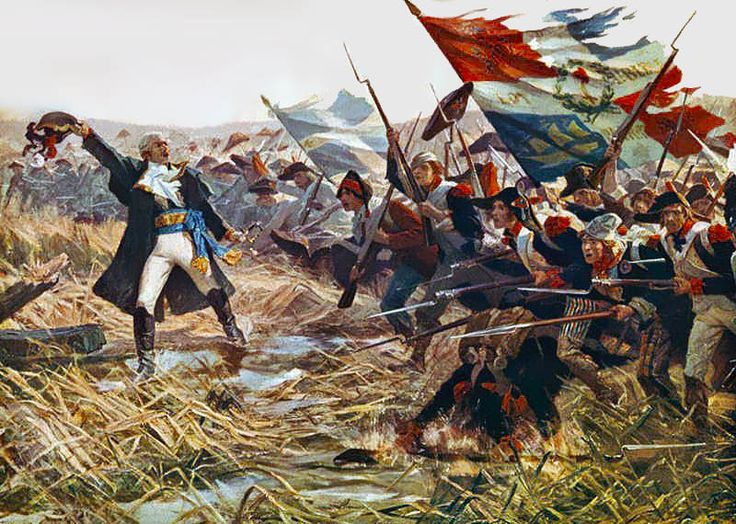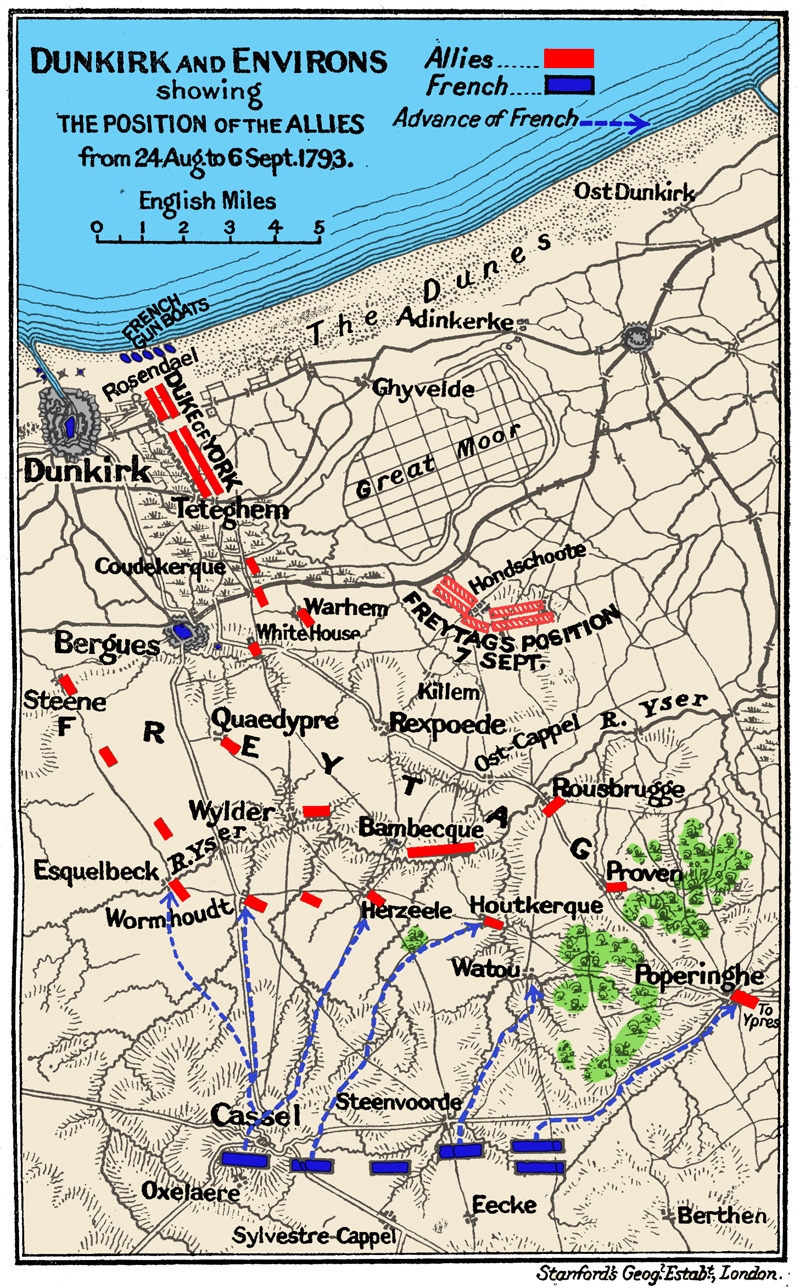|
Battle Of Lincelles
The Battle of Lincelles was an action that took place as part of a larger manoeuvre on 17 August 1793 in the Low Countries theatre of the War of the First Coalition, Flanders Campaign of the War of the First Coalition. It was fought between the forces of Revolutionary France under the command of Jean Baptiste Jourdan and , versus those of Great Britain under Frederick Augustus, Duke of York and Albany and the Dutch Republic under the William I of the Netherlands, Hereditary Prince of Orange. The action resulted in a coalition victory. The battle In the Autumn of 1793 the Allied forces of Prince Josias of Saxe-Coburg-Saalfeld were poised to invade France. The William I of the Netherlands, Hereditary Prince of Orange held Menen, Menin with 10,000 Dutch troops, with instructions to cover the movement of the corps of Prince Frederick, Duke of York and Albany in his advance towards Dunkirk. To facilitate this and take advantage of York's nearby support Orange decided to lead a col ... [...More Info...] [...Related Items...] OR: [Wikipedia] [Google] [Baidu] [Amazon] |
Low Countries Theatre Of The War Of The First Coalition
The Low Countries theatre of the War of the First Coalition, also known as the Flanders campaign, was a series of campaigns in the Low Countries conducted from 20 April 1792 to 7 June 1795 during the first years of the War of the First Coalition. As the French Revolution radicalised, the revolutionary National Convention and its predecessors broke the Catholic Church's power (1790), abolished the monarchy (1792) and even executed the deposed king Louis XVI of France (1793), vying to spread the Revolution beyond the new French Republic's borders, by violent means if necessary. The First Coalition, an alliance of reactionary states representing the Ancien Régime in Central and Western Europe – Habsburg Austria (including the Southern Netherlands), Prussia, Great Britain, the Dutch Republic (the Northern Netherlands), Hanover and Hesse-Kassel – mobilised military forces along all the French frontiers, threatening to invade Revolutionary France and violently restore the m ... [...More Info...] [...Related Items...] OR: [Wikipedia] [Google] [Baidu] [Amazon] |
Antoine Anne Lecourt Béru
Antoine is a French given name (from the Latin ''Antonius'' meaning 'highly praise-worthy') that is a variant of Danton, Titouan, D'Anton and Antonin. The name is most common in France, Switzerland, Belgium, Canada, West Greenland, Haiti, French Guiana, Madagascar, Benin, Niger, Burkina Faso, Ivory Coast, Guinea, Senegal, Mauritania, Western Sahara, Morocco, Algeria, Tunisia, Chad, Central African Republic, Cameroon, Equatorial Guinea, Gabon, Republic of the Congo, Democratic Republic of the Congo, Burundi, and Rwanda. It is a cognate of the masculine given name Anthony. Similar names include Antaine, Anthoine, Antoan, Antoin, Antton, Antuan, Antwain, Antwan, Antwaun, Antwoine, Antwone, Antwon and Antwuan. Feminine forms include Antonia, Antoinette, and (more rarely) Antionette. As a first name *Antoine Alexandre Barbier (1765–1825), a French librarian and bibliographer *Antoine Arbogast (1759–1803), a French mathematician *Antoine Arnauld (1612–1694), a French theologia ... [...More Info...] [...Related Items...] OR: [Wikipedia] [Google] [Baidu] [Amazon] |
Military History Of Nord (French Department)
A military, also known collectively as armed forces, is a heavily armed, highly organized force primarily intended for warfare. Militaries are typically authorized and maintained by a sovereign state, with their members identifiable by a distinct military uniform. They may consist of one or more military branches such as an army, navy, air force, space force, marines, or coast guard. The main task of a military is usually defined as defence of their state and its interests against external armed threats. In broad usage, the terms "armed forces" and "military" are often synonymous, although in technical usage a distinction is sometimes made in which a country's armed forces may include other paramilitary forces such as armed police. Beyond warfare, the military may be employed in additional sanctioned and non-sanctioned functions within the state, including internal security threats, crowd control, promotion of political agendas, emergency services and reconstruction, prot ... [...More Info...] [...Related Items...] OR: [Wikipedia] [Google] [Baidu] [Amazon] |
Conflicts In 1793
Conflict may refer to: Social sciences * Conflict (process), the general pattern of groups dealing with disparate ideas * Conflict continuum from cooperation (low intensity), to contest, to higher intensity (violence and war) * Conflict of interest, involvement in multiple interests which could possibly corrupt the motivation or decision-making * Cultural conflict, a type of conflict that occurs when different cultural values and beliefs clash * Ethnic conflict, a conflict between two or more contending ethnic groups * Group conflict, conflict between groups * Intragroup conflict, conflict within groups * Organizational conflict, discord caused by opposition of needs, values, and interests between people working together * Role conflict, incompatible demands placed upon a person such that compliance with both would be difficult * Social conflict, the struggle for agency or power in something * Work–family conflict, incompatible demands between the work and family roles of ... [...More Info...] [...Related Items...] OR: [Wikipedia] [Google] [Baidu] [Amazon] |
1793 In France
Events from the year 1793 in France. Incumbents *The National Convention *The Committee of Public Safety (de facto from 6 April) Events January to June *21 January – French Revolution: After being found guilty of treason by the French National Convention, ''Citizen Capet'', Louis XVI of France, is guillotined in Paris. *1 February – French Revolutionary Wars: The French First Republic declares war on Kingdom of Great Britain, Great Britain, the Dutch Republic and (soon afterwards) Spain. *11 February – French expedition to Sardinia (''Expédition de Sardaigne''): A French fleet under Laurent Jean François Truguet, admiral Laurent Truguet debarks troops near Cagliari in Sardinia. *22 February – French expedition to Sardinia: A small French and Corsican force briefly occupies the small Sardinian island of La Maddalena, then withdraws to Corsica. 23-year-old lieutenant Napoleon Buonaparte is second-in-command. *6 April – French Revolutionary Wars: The Committee of Pub ... [...More Info...] [...Related Items...] OR: [Wikipedia] [Google] [Baidu] [Amazon] |
Siege Of Dunkirk (1793)
The siege of Dunkirk took place in the Autumn of 1793 when British, Hanoverian, Austrian, and Hesse-Kassel troops under the command of Prince Frederick, Duke of York besieged the fortified French border port of Dunkirk, as part as the Flanders campaign of the French Revolutionary Wars. Following a Coalition defeat at the Battle of Hondshoote they were forced to raise the siege and withdraw northeast. Siege The decision to besiege Dunkirk was taken not by military commanders, but by the British government, chiefly by William Pitt's closest advisor, Secretary of State for War Henry Dundas. Dundas had considered the possession of Dunkirk as desirable, both as a bargaining chip in negotiations and as a potential British base in Europe. As a military objective towards winning the war, however, it was likely a mistake, as it prevented Prince Frederick, Duke of York from supporting the main Allied thrust further inland, and losing the strategic initiative. Nevertheless, York ... [...More Info...] [...Related Items...] OR: [Wikipedia] [Google] [Baidu] [Amazon] |
Lille
Lille (, ; ; ; ; ) is a city in the northern part of France, within French Flanders. Positioned along the Deûle river, near France's border with Belgium, it is the capital of the Hauts-de-France Regions of France, region, the Prefectures in France, prefecture of the Nord (French department), Nord Departments of France, department, and the main city of the Métropole Européenne de Lille, European Metropolis of Lille. The city of Lille proper had a population of 236,234 in 2020 within its small municipal territory of , but together with its French suburbs and exurbs the Lille metropolitan area (French part only), which extends over , had a population of 1,515,061 that same year (January 2020 census), the fourth most populated in France after Paris, Lyon, and Marseille. The city of Lille and 94 suburban French municipalities have formed since 2015 the Métropole Européenne de Lille, European Metropolis of Lille, an Indirect election, indirectly elected Métropole, metropolitan ... [...More Info...] [...Related Items...] OR: [Wikipedia] [Google] [Baidu] [Amazon] |
Bondues
Bondues (; ) is a commune in the Nord department in northern France. Since 1997, Bondues has housed a Museum devoted to the Resistance of the Nord-Pas de Calais region. The Fort of Bondues, also known as Fort Lobau, was built near the confluence of the Marque and Deûle rivers, by General Séré de Rivières, from 1877 to 1880. It is an element of the chain of forts and fortifications constituting the defence system around Lille. It was the place of execution of 68 members of the resistance in 1943/4. Population Heraldry International relations Bondues is twinned with: * Haywards Heath, West Sussex, England (since 1992) * Wülfrath, Germany (since 2003) Sports FC Bondues is a local soccer club. Merge between the historical US Bondues and the CJ Bondues. President Herbaux and his crew help with the continual growth of the club which will compete at the highest level yet in 2023 in the R1 division. Legends of the club are: Martin Colpaert, Kevin Jehu, Jean Decru, Arn ... [...More Info...] [...Related Items...] OR: [Wikipedia] [Google] [Baidu] [Amazon] |



